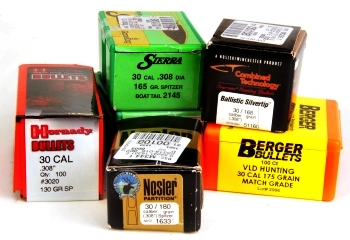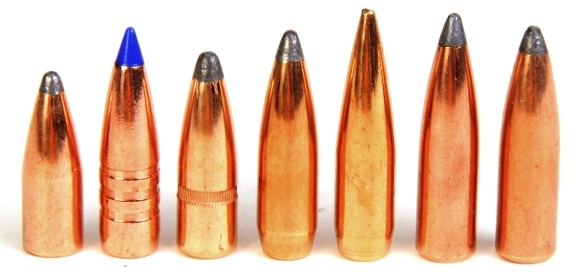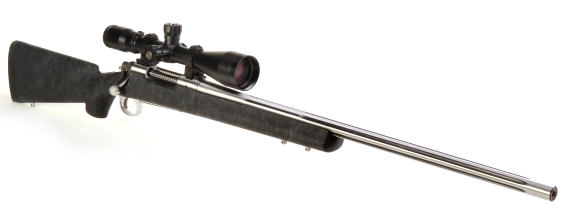I bought a Remington Sendero because… I like the way it looks. Then I liked the way the big magnum shot, so much so that I could see the practical application for an 8 lb 12 oz rifle. When I am not shooting it on the 100 yard home course, I’m perfectly happy driving half way to New Hampshire so I can spend the afternoon shooting the Sendero over long distances. Perhaps one day I will get in the truck and drive to Wyoming, or Montana and pop a nose thumbing pronghorn at 600 yards or go on a safari so I can drop an giant Eland running ahead of a pack of marauding hyenas? The important thing, when I began writing this piece, was that I was looking for any excuse to shoot this rifle and to develop handloads in addition to those that were
developed previously for the .300 Ultra Mag.
The value of my experience… Not much
When I find a bullet that works, I buy a bunch of them. Bullets don’t get stale, they don’t get tired, they just sit in boxes waiting to be used… even if some are marked to promote the introduction of the “New and exciting .308 Winchester”. If a bullet performed flawlessly from 1968 to 1978 over seasons of heavy deer and antelope hunting, chances are it should be just as effective on today’s post disco deer and antelope.

When it came to selecting project bullets, empirical data spoke to me. It said, “Joe, I’m not familiar with the Berger bullet, but the rest did a bang up job for hunting and recreational target shooting”. So I loaded and shot some through the Sendero into paper targets and ballistic gel, then made a couple of adjustments and ended up with those pictured below.
There is a lot to be said for gratuitous pictures of bullets…
A Barnes 130 Grain TTSX bullet, second from left, was added to the list. The 130 grain Hornady bullet – far left, has a thin jacket and is designed to upset even at moderate velocity. I know I get upset over moderate velocity also. That makes the Hornady bullet suitable for long range coyote hunting, but not for anything much larger. The Barnes solid copper bullet will expand on thin skilled game, but it will also hold together and retain the bulk of its weight. The 168 Grain CT Silvertip was dropped because of its thin jacket and design for explosive expansion which would make it a way heavy duty gopher gun. A 150 grain Winchester Power Point bullet, third from left, was added for medium size game because it is a pretty tough slug and it really smoked in velocity for a 150 grain bullet. The line is listed top to bottom on the table that follows a few paragraphs from here.
Conventional wisdom says, bullets pointed side up and use primers as often as possible…
Long range shooting beyond two hundred yards or more, or whatever distance you look out and say, “Whoa dude, that’s really far!” benefits from a little extra care when assembling handloads for the simple reason that distance amplifies errors. My contribution to the land of great specialization is using to pull brass from the same source and same sized and/or fire formed or new condition. I trim cases to a uniform length, I pay particular attention to seating bullets to the same depth, and I carefully metering powder charges with an electronic scale. The objective for all of this is to end up with uniform chamber pressure, uniform velocity and the greatest potential for consistent shot to shot placement. These are the things I can do that can be justified with measureable and repeatable improvements in performance over handloads that don’t receive this treatment.
I do not seat bullets out to get them particularly close to the rifling leade. Bullet weights vary and bullet length often determine cartridge overall length that won’t place a bullet close to rifling. I’m more concerned with having uniform bullet heel depth that will assure uniform case neck to bullet shank contact as this will result in an equal case hold on all bullets regardless weight and length. I do use a concentricity checker to make sure I am not assembling in some way that causes an axial alignment problem, however, I do not use a concentricity gauge to correct an out of alignment condition as the only way the bullet can be moved is by breaking the symmetry of the case neck. Beside, closing the bolt on an assembled round where the freebore is no more than 0.001″ greater than bullet diameter will correct and cartridge axial alignment problems.
Handload score card…
|
.300 Ultra Mag Handloads – 26″ Barrel Remington Sendero SF II
|
| Bullet Mfg |
Bullet # |
Weight
Grains |
Length
“ |
COL
“ |
Powder
Type |
Powder
Charge |
Actual
Velocity |
Muzzle
Energy |
3 Shot Group” |
| Hornady SP |
3020 |
130 |
0.940 |
3.480 |
Re25 |
100.5 |
3668 |
3885 |
1.2 |
| |
|
|
|
|
AA MagPro |
102.0 |
3583 |
3707 |
1.1 |
| |
|
|
|
|
RS Magnum |
105.0 |
3656 |
3859 |
1.4 |
| Barnes TTSX |
30873 |
130 |
1.175 |
3.500 |
Re25 |
99.5 |
3740 |
4039 |
0.9 |
| |
|
|
|
|
AA MagPro |
101.0 |
3678 |
3906 |
0.8 |
| |
|
|
|
|
RS Magnum |
103.0 |
3644 |
3834 |
1.3 |
| Winchester PP |
WB30PP150 |
150 |
1.050 |
3.600 |
Re25 |
99.0 |
3416 |
3888 |
0.5 |
| |
|
|
|
|
H1000 |
101.5 |
3462 |
4002 |
0.8 |
| Sierra Game King |
2145 |
165 |
1.185 |
3.590 |
Re25 |
95.5 |
3443 |
4344 |
0.7 |
| |
|
|
|
|
H1000 |
97.0 |
3312 |
4020 |
0.9 |
| Berger VDL Hunting |
30512 |
175 |
1.282 |
3.600 |
Re25 |
94.0 |
3274 |
4166 |
0.8 |
| |
|
|
|
|
H1000 |
94.0 |
3254 |
4116 |
0.6 |
| Nosler Partition |
1633 |
180 |
1.270 |
3.600 |
H1000 |
95.0 |
3291 |
4330 |
1.1 |
| |
|
|
|
|
H870 |
104.0 |
3277 |
4293 |
1.2 |
| Sierra Pro-Hunter |
2150 |
180 |
1.210 |
3.600 |
H1000 |
95.0 |
3297 |
4346 |
0.9 |
| |
|
|
|
|
Retumbo |
99.5 |
3317 |
4399 |
0.8 |
|
Maximum C.O.L. 3.600″ – CCI 250 Primers – Maximum Loads, back off and work up – Groups 100 Yards
|
Impressions, besides those left on my right shoulder…
The Remington’s Model 700™ Sendero® SF II is… a gun with a very long name. The slight bump in weight over a sporter makes for a lot more shooting comfort as does the design and composition of the synthetic stock. The cartridge if spiffy, easy to handload and it packs plenty of long range punch. The gun can shoot a lot more accurately than me, but I thought it shot pretty good for all of my distractions and need to rush to get back from the range. I’ll keep it handy so whenever I get a chance to do some shooting it will be right there with me. In fact, I am already planning a Part III with a bit more exotic of a bullet selection. I also need to build one of these that has a 26″ barrel, but weighs less than 7 lbs.





Email Notification